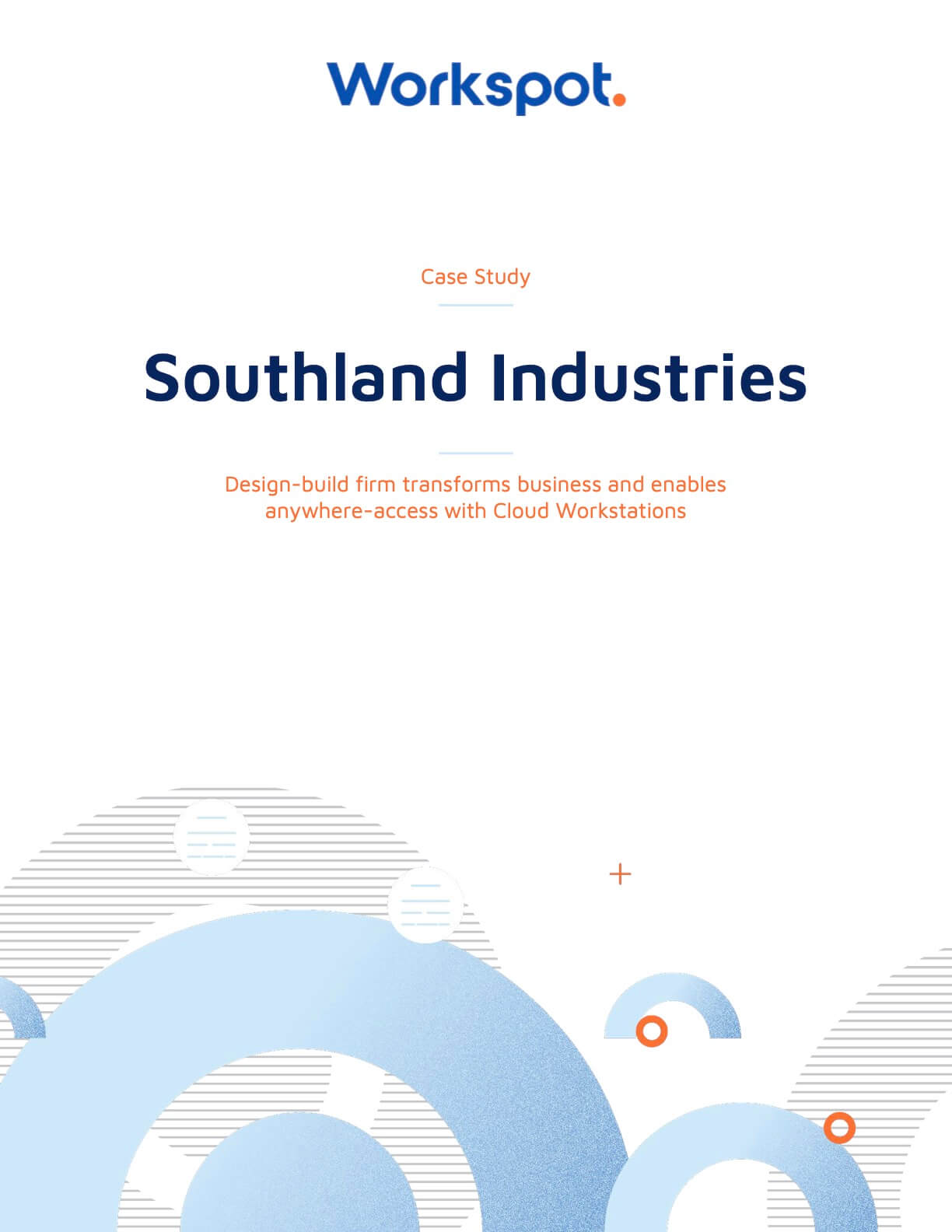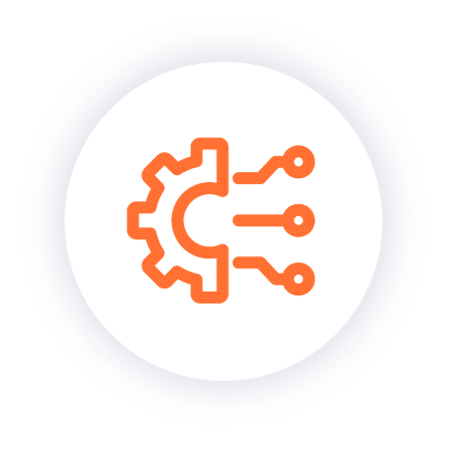Southland Industries
Design-build firm transforms business and enables anywhere-access with Cloud Workstations
COMPANY OVERVIEW
Southland Industries was founded in 1949 and is one of the nation’s largest mechanical, engineering and plumbing (MEP) building systems experts. Southland specializes in the design, construction, and service of mechanical, plumbing, fire protection, process piping, automation and controls systems, as well as comprehensive energy services for large organizations, including government, hospitals, universities, stadiums and museums.
CHALLENGE
Effective collaboration across project teams is paramount.
Southland’s challenge is to deliver creative solutions for complex building designs, efficiently and cost-effectively. They discovered that to continue the firm’s healthy growth, they needed more flexible IT infrastructure, including an easier way to manage engineering workstations and massive amounts of data generated from building projects.
As they design MEP solutions, project teams use expensive, water-cooled GPU workstations to produce work, which includes creating complex drawings of plumbing, fire suppression and heating and air conditioning systems for new buildings. The limitations of using physical workstations became clear as power users expressed disappointment about being unable to work from home, supporting new projects often required building out expensive branch offices, and project teams found it difficult to collaborate on designs efficiently. Each of these challenges cost the firm in terms of lost productivity & significant infrastructure and IT resource expense. The Southland IT infrastructure team knew they had reached a crossroads; they needed to invest more in the existing distributed infrastructure or completely change the way they were operating.
Complex data replication
To facilitate collaboration, Southland began replicating data across more than 17 locations – wherever project team members were located. To avoid overwriting another designer’s work, Southland uses real-time file lock and sync software which works well. However, the growing volume of data that needed to be replicated was becoming unmanageable. To illustrate the significance of the data replication issue, Israel Sumano, Southland’s Senior Director of Infrastructure Services, points to a project they completed in Fort Hood. “The scope of this challenge becomes clear when you consider that this single project has over one terabyte of data stored for the building drawings. Multiplied over hundreds of projects, it was fast becoming unsustainable – both from a revision-control and cost standpoint – to replicate, maintain, sync and lock all of this data.”
Cost of opportunities and accessing talent
As they pursued new opportunities, Southland found that tackling new projects in regions where they did not already have an office added significantly to project costs. Spinning up a branch office with the required on-premises IT infrastructure, including networking and physical GPU workstations, cost $150K at minimum, even if there were only two engineers in that office. An even bigger issue is when the right talent is not available in close proximity to a project location.
Joint venture operation complexity
If power user collaboration within the firm is difficult, one can imagine the challenges when multiple firms partner together on a building project. Joint ventures in the AEC industry are quite common, and successful partnerships can pay significant dividends in the form of access to larger project opportunities and expansion into new geographic areas. However, core to a successful joint venture is the ability to share knowledge and collaborate effectively across project teams that could be distributed across the country or around the world. With each partner coming to the table with disparate IT systems, collaboration is cumbersome and orchestrating IT infrastructure to better support joint ventures is complicated to use and costly to deploy. Performance often suffers, and that compromises the primary thing that a joint venture is formed to do in the first place: drive productivity & produce superior outcomes for clients. As a participant in many joint ventures, the Southland team sought a new approach to IT that would simplify the operation of these alliances.
Traditional VDI was not the answer
The Southland IT team is very forward thinking, and as such they initially explored virtual desktop infrastructure (VDI) as a solution to these challenges. Although they exhaustively tested VDI solutions from different vendors over several years, they found that the performance of those solutions was just not adequate for their demanding power users, and they knew their designers and BIM managers would be unhappy.
Traditional VDI is also very complex and expensive to manage. Sumano stated, “With VDI, I’d need to hire two full-time people just to babysit the solution and hope that it doesn’t break. These solutions are too complex to troubleshoot, and we cannot afford the downtime that comes with that complexity.”
SOLUTION
Hire the best engineering talent and give them the ability to collaborate in real-time from anywhere, using high-performance, cloud GPU workstations.
A new approach
With all the disappointment resulting from their prior VDI evaluations, it was with healthy skepticism that Israel responded to Workspot’s offer to evaluate cloud workstations on Workspot.
At that time, Workspot approached Southland with the news that GPUs were available in Microsoft Azure and they introduced Southland to a completely different way for their CAD engineers and BIM managers to work. Unlike their prior experience with VDI, “With Workspot and one engineer, we had a working solution in a week,” said Sumano.
Southland power users work with graphics-intensive applications including Autodesk Revit, AutoCAD and Navisworks. Because these users must have top performance while working and collaborating on complex designs, their satisfaction was fundamental to adopting the solution.
After a limited initial rollout to gauge user satisfaction, the Southland team found the performance of Workspot cloud workstations to be as good or better than their physical workstations. At the same time, Southland is able to realize all of the other benefits of transitioning physical workstations to Workstation Cloud on Microsoft Azure. Southland now runs Workspot workstations built on Azure NVv4 VMs powered by AMD Radeon Instinct™ GPUs and 2nd Gen AMD EPYC™ processors.
BUSINESS RESULTS
Complete transformation
Three months into the rollout, Southland had 200 “very demanding” users running on Workspot’s solution. Sumano stated, “Workspot brought ease of use to a solution that has been very cumbersome in the past. Workspot is simple to deploy, simple to use and maintain, and it’s easy to scale across cloud regions.”
The firm continues to expand its use of cloud workstations – to its Southern California division, to its Portland office and to hundreds more users.
Streamlined IT infrastructure, better collaboration
With engineers now free to more easily collaborate and able to be productive anywhere, Southland no longer has to grapple with the cost and complexity of replicating massive amounts of data to multiple local data centers and regional offices. When they need to launch a new job site, it can be achieved in 10 minutes. A Meraki firewall is shipped to a jobsite, it’s plugged in and they’re connected to Southland’s network. The engineers at the job site can then access their cloud workstations and immediately get to work!
Additionally, Southland can avoid the significant expense associated with acquiring, refreshing and maintaining physical workstations. “I don’t have to buy expensive workstations anymore; now I can buy a $700 Microsoft Surface and our designers can connect to Workspot cloud workstations in the Azure region closest to them” says Sumano.
They are so pleased with Workstation Cloud, Sumano says “In the next 3 years, we plan to get rid of our on-premises infrastructure.”
Open doors for new talent
Another primary benefit is their ability to hire the best people from all over the country, on-board them quickly and cost-effectively, and allow them to work from anywhere, using state-of-the-art, continually evolving technology from Workspot, Microsoft and NVIDIA. Sumano said, “Now we can hire from anywhere. For example, if a talented kid is graduating from Alaska State and he is someone we want to hire, we don’t have to relocate him – we just provide him with a cloud workstation and he can work from home.”
Improve joint venture ROI
Southland’s goal is not only to have the entire company using Workspot Workstation Cloud, but to feature it as the technology platform of choice when they are the lead on a joint venture project. The collaboration, scalability and ease of use benefits of Workstation Cloud make it the perfect fit for accommodating the dynamics of joint ventures as they form, carry out their work and are ultimately dissolved. The simplicity of setting up a pool of cloud workstations dedicated to a partnership means that the project can launch faster and deliver results sooner, more cost effectively.
Latest Resources
We're here to help! Access these valuable resources to help guide your journey to cloud desktops.

Power Your GPU Apps with Workspot
Graphics processing units (GPUs) and virtual GPUs play a key role in powering graphics-intensive applications used by engineers and designers, on Google Cloud, on-premises, and across geographic regions... Read more





